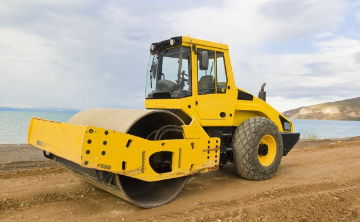- info@hightoptools.com
- Monday - Sunday 9.00 - 18.00
WhatsApp: +86 18162052962

Roller rolling operation process
1. During operation, the roller should start before it starts to vibrate. The internal combustion engine should be set to medium speed first, and then adjusted to high speed.
2. The engine should be stopped first when shifting and reversing, and the engine speed should be reduced when shifting.
3. It is strictly forbidden for the roller to vibrate on a solid ground.
4. When rolling a soft roadbed, you should first roll it 1-2 times without vibration, and then vibrate it.
5. When rolling, the vibration frequency should be consistent. For a vibratory roller that can adjust your vibration frequency, you should first adjust the vibration frequency before working. Do not adjust the vibration frequency without starting vibration.
6. The adjustment of the reversing clutch, shock clutch and brake should be carried out after the main clutch is disengaged.
7. When going up or downhill, fast gears are not allowed. In sharp turns, including articulated vibratory rollers when rolling in small turns, fast gears are strictly prohibited.
8. The roller shall not engage with vibration when it is running at high speed.
9. When stopping, stop the vibration first, then place the reversing mechanism in the middle position, place the transmission in neutral, and finally pull up the hand brake lever, and the internal combustion engine will turn off after idling for a few minutes.
10. Other operating requirements should meet the requirements of static pressure rollers.
Roller rolling skills
①Whether it is uphill or downhill, the bottom layer of the asphalt mixture must be clean and dry, and the asphalt binding layer must be sprayed to avoid slippage of the mixture during rolling.
②Whether it is rolling uphill or rolling downhill, the driving wheel of the roller should be behind. This has the following advantages: When going uphill, the rear driving wheels can withstand the driving force provided by the ramp and the machine itself, while the front wheels initially compact the road surface to withstand the greater shearing force generated by the driving wheels ; When going downhill, the impact force generated by the roller's own weight is offset by the braking of the driving wheels. Only the mixture after being rolled by the front wheels can support the rear driving wheels to generate shearing force.
③When rolling uphill, the roller should start, stop and accelerate smoothly to avoid excessively high or low speed.
④Before uphill rolling, the mixture should be cooled to the specified lower limit temperature, and then statically pre-compressed. When the temperature of the mixture drops to the lower limit (120℃), vibration compaction should be used.
⑤When rolling downhill, avoid sudden shifting and braking.
⑥When rolling downhill under very steep slopes, a light roller should be used for pre-compaction, and then a heavy roller or vibratory roller should be used for compaction.
Low temperature influence of roller
Low temperature makes it difficult to start the engine. The main reasons are the increase in the viscosity of the lubricating oil, the decrease in the working capacity of the battery and the poor fuel atomization.
The viscosity of engine oil increases as the temperature decreases, and the flow performance becomes worse, which makes the engine lubrication conditions worse and the rotation resistance of the crankshaft increases.
When the battery is at low temperature, the viscosity of the electrolyte also increases, the penetration ability decreases, and the increase in internal resistance causes the battery capacity and terminal voltage to decrease significantly, and even cannot discharge. The voltage drop makes the starter unable to obtain the required output power, and it is difficult to meet the requirements of the starting speed.
Due to the low temperature, the crankshaft speed for starting the engine is not high, the temperature of the intake pipe and the gas flow rate are low, and the quality of fuel atomization is poor, which further increases the difficulty of starting the engine.
Under low temperature conditions, various oils have high viscosity and poor fluidity, which brings difficulties to the operation of the roller and aggravates the wear of the parts.
The viscosity of the lubricating oil is large, the oil stirring power loss during the operation of the mechanism increases, the engine power is reduced, and the efficiency of the transmission system is low, thereby reducing the driving ability of the roller walking and the excitation mechanism.
The poor fluidity of lubricating oil adds difficulty to the lubrication of certain parts and reduces the lubrication effect, thereby intensifying the wear of the engine and transmission parts.
The high viscosity of the working fluid also increases the resistance of the pipeline, which makes the hydraulic steering operation difficult, the efficiency of the hydraulic drive brake becomes poor, and the driving difficulty is increased, which has an adverse effect on safe driving.
There are common freezing hazards during construction in cold seasons. For example, the freezing of battery electrolyte will cause it to stop working; the freezing of water-cooled engine cooling water will freeze the radiator and cylinder block.
Leave a comment